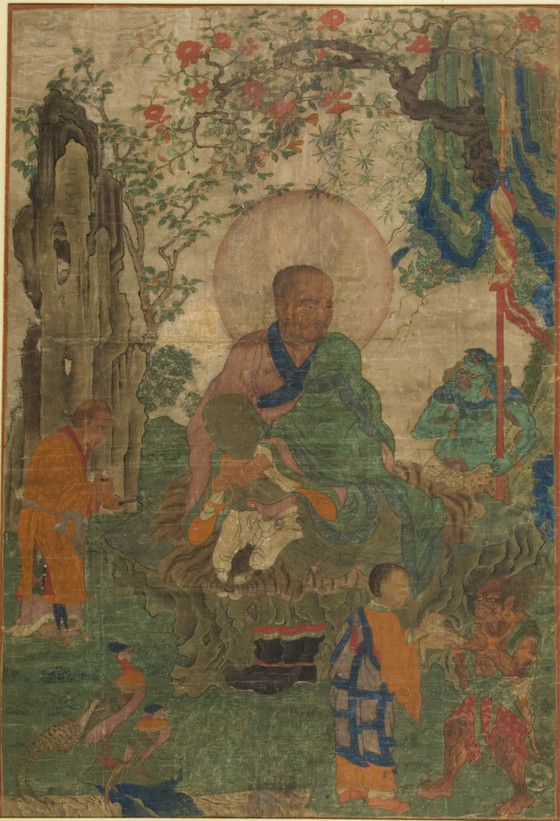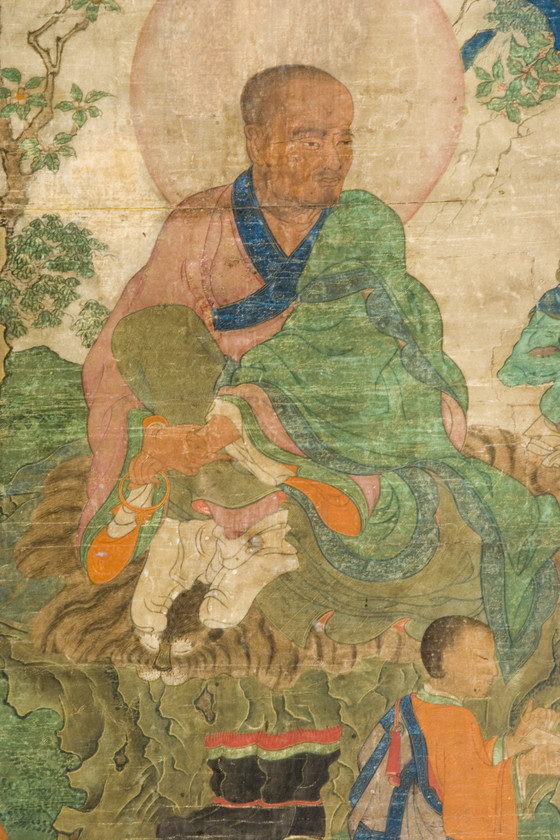Curator Notes
This painting and its five set mates (M.2005.154.1-.6) were originally part of a Tibetan set of the Sixteen Great Arhats (Buddhist saints) reportedly from a Trungpa Monastery in Surmang in the Kham region of northeast Tibet bordering China. Founded in the 15th century by the Mahasiddha Trungmase and now known collectively as the Surmang Monastery, it was a complex of nine monasteries that was the home of the Trungpa tulkus (incarnate lamas) in the Kagyu lineage. The Surmang monasteries were destroyed in 1958 during the Chinese invasion of Tibet.
The six paintings in the LACMA set are important examples of the Sino-Tibetan style of thangka painting that was heavily influenced by Chinese landscape traditions and figural conventions. Five of the paintings portray Arhats inspired by Chinese Ming prototypes, such as the portrait of the Arhat Chudapanthaka attributed to circa 1500 in the Museum of Fine Arts, Boston (08.176). The Arhats or Lohans were first worshiped in China during the Six Dynasties Period (222-589) and were widely depicted in art by the Tang Dynasty (618-906). The sixth painting in the LACMA set depicts two of the Guardian Generals of the Directions (Lokapalas) who were typically included in Tibetan sets of the Sixteen (and later Eighteen) Great Arhats. See also M.71.107, M.77.155.1, M.83.105.18, and M.86.336. A comparable partial set of 18th-century Sino-Tibetan Arhat paintings is in the Museum of Fine Arts, Boston (59.276-.280, .282-.285). See also Stephen Little, "The Arhats in China and Tibet," Artibus Asiae 52:3/4 (1992): 255-281.
This painting portrays the Arhat Kalika (name derived from kala, time or black; set no. 4). He is usually represented holding two large, ornamented earrings made from offerings that he received in gratitude for having taught the Dharma to the divine beings in heaven, but here the artist has unusually depicted him holding a single gold earring in his left hand. Devotees believe that by seeing or touching the earring/s, they will receive the blessings of all the Buddhas and Bodhisattvas. Kalika is nimbate and seated on a rock throne covered by a tiger skin. He is said to have a retinue of 1100 disciples, who are here represented by two monks. There are also two demons. One carries a standard, while the other receives a sacred text from a monk. A variegated peacock and peahen are in the lower left corner.
Comparable Eastern Tibetan portraits of Arhat Kalika are in the Metropolitan Museum of Art, New York (30.76.289) and Rubin Museum of Himalayan Art, New York (F1998.10.3).
More...




